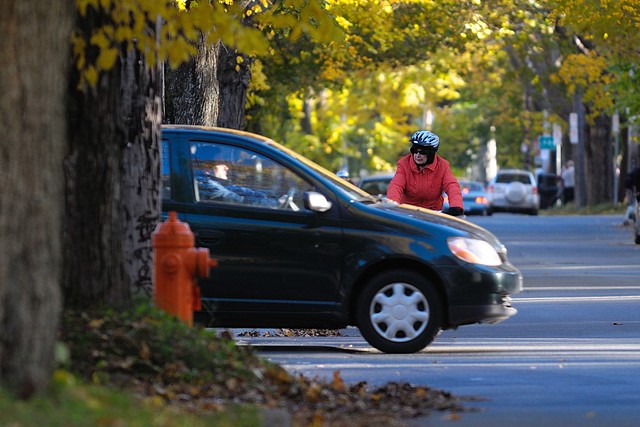NOVA SCOTIA – Late on November 4th, the Nova Scotia NDP Government released that changes to the Motor Vehicle Act which acknowledge cyclists would be reviewed during this session of the House of Assembly on the evening of Monday, November 15th, 2010. The change to the legislation came about when the province consulted with members of the cycling community, including non-profit organizations, coalitions and active cyclists, to “clarify and define the roles and responsibilities of bicyclists and motorists.”
As per the press release on November 4th: “The amendments to the Motor Vehicle Act legislation will enhance current bicycle legislation and require drivers to leave one meter of open space between the vehicle and bicyclist when passing”. Alongside this “one meter rule” a more recent press release issued on November 15th, revealed that the Motor Vehicle Act amendment will also:
- define ‘cyclist’ and ‘bicycle lane’
- prohibit vehicle parking in a bicycle lane
- make it an offence to fail to yield to a cyclist in a bicycle lane
- redefine cycling on the extreme right
- allow drivers of vehicles to cross a centre line to pass a bicycle, if the driver can do so safely
- require cyclists to ride single file and in the same direction of the traffic.
In other jurisdictions, the “one meter rule” also applies to other vulnerable road users, including pedestrians on rural highways, road workers, equestrians, vehicle breakdowns and slow moving vehicles.
“The Nova Scotia Bikeways Coalition fully supports the amendment and actively supports other legislation that will be put in place to protect cyclists and other vulnerable road-users,” states Scott MacPhee, Chair of the Nova Scotia Bikeways Coalition. “The ‘one meter rule’ amendment provides a safety zone for all cyclists everywhere, even on roads that can’t accommodate the defined and marked bike lane.”
MacPhee further explains that “the term ‘bike lanes’ has been included in the proposed legislation which is really great.” Nova Scotia is the first Canadian province to propose the “one meter law” which already exists in 15 American state. What’s progressive about this proposed legislation is that the provincial government acknowledges that roads are currently unsafe for cyclists and the current Motor Vehicle Act creates confusion concerning cycling infrastructure, by not including “bike lanes” and definitions and rules pertaining to cyclists. By listening to cycling advocates and discussing amendments such as these, the NS government will instill greater confidence in cyclists regarding their rights to and on the road.
In adding the term “bike lane” into the Motor Vehicle Act, as well as the “one meter rule”, the government hopes to increase the safety of cyclists with the proposed amendment. MacPhee states that “this ‘one-meter amendment’ to the Motor Vehicle Act [that defines the distance between cars and cyclists] on the road is progressive; by including ‘bike lane’ in the act the proposed amendment also brings awareness to automobile users that they are required by law to give more room to cyclists on the road or suffer monetary consequences.”
As reported in the Digital Journal, Transportation and Infrastructure Renewal spokesperson Lindsay Lewis states, “The proposed penalty for failing to abide by the ‘one meter law’ would be $455.26 including court costs and the fine for driving in a bicycle lane would be $1260.21.”
Despite a left turn in the right direction (acknowledging that cyclists have a right to be on the road), the one meter rule is an invisible line between motorists and cyclists and one that could be easily argued not to exist at all. MacPhee indicates, if a collision were to occur, “it will certainly be hard to enforce as it would require the police to be present [to ensure that the one-meter was in effect].” However, the legislation change as indicated in Bill-84, illustrates that “(3) In the case of a collision between a bicycle and a vehicle, the driver of the vehicle is presumed not to have left the safe distance required by subsection (1). (4) Subsection (3) does not apply if it is determined that the rider of the bicycle: (a) was operating the bicycle in an unsafe or risky manner; or (b) wilfully violated the safe travelling distance.”
While the “one meter rule” amendment will improve communication between cyclists and auto-users, acknowledge cyclists participation by improving their rights and access to the road, increase the confidence of cyclists as acknowledged transportation users, clearly communicate the space required between vehicles and cyclists (and other vulnerable road-users), and define bike lanes as cyclist-only thorough-way, cyclists also have a valuable role to play in maintaining the rules of the road.
Transportation and Infrastructure Renewal spokesperson Lindsay Lewis said, in the Digital Journal on November 16th, “The bill was introduced in the legislature Monday, [November 15th]. If passed it could be a number of weeks before the law is enforced.” If the amendment is passed Transportation and Infrastructure Renewal will be offering a public education component. To stay informed visit: http://www.gov.ns.ca/tran/thedepartment.asp.
The Nova Scotia Bikeways Coalition works to increase Nova Scotia cycling infrastructure through municipal, provincial and federal levels. The NS Bikeways Coalition has recently started to map cycling infrastructure through GIS. The Coalition hopes that the GIS database will work to unify the conversation regarding, and to improve, infrastructure for cyclists. To get involved, please visit: http://bikeways.ca/.
For more information on Bicycle Safety in Nova Scotia, please visit:http://www.gov.ns.ca/snsmr/rmv/safe/Bicycle_Safety_hl.pdf.
Photo by Lawrence Plug


2 comments
Excellent article. And a big hurrah for TIR, the NDP, Andrew Younger and everyone else who has worked toward these amendments!
If passed, some examples for Ontcario, though enforcement is another thing.